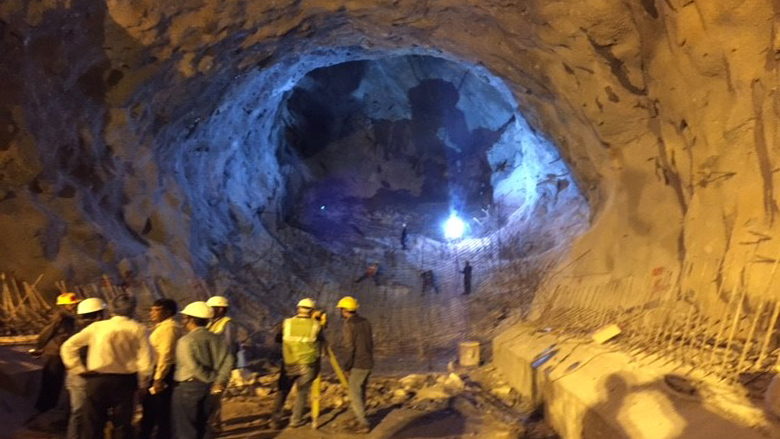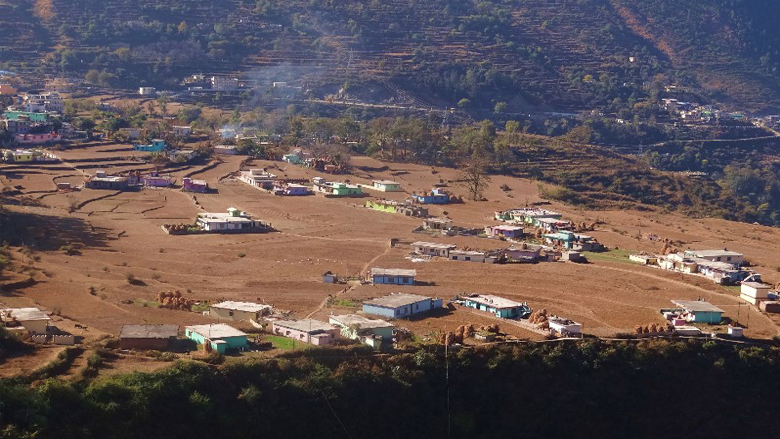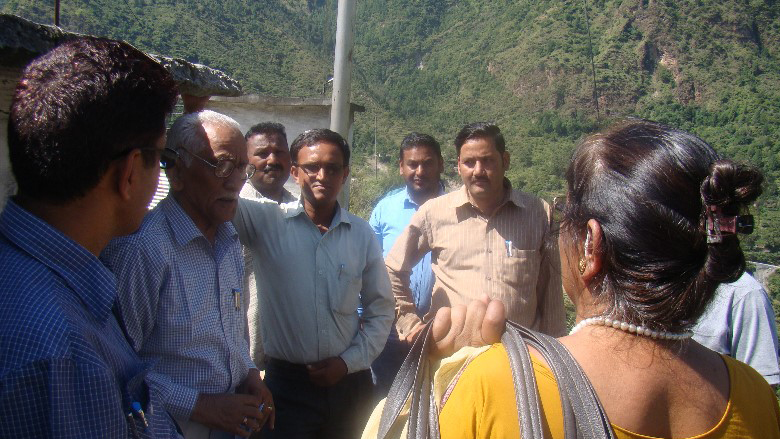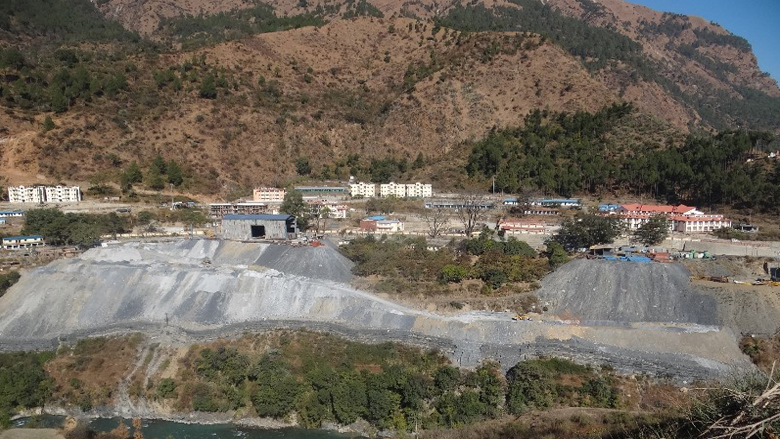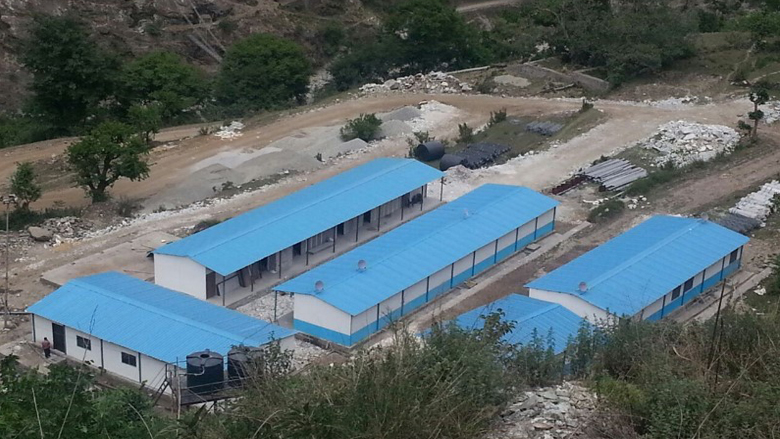Relocation Progress of Haat Village:
As of September 2016, 77 households out of the 83 eligible, have received at least one installment of a special grant of INR 1 million. So far 76 families have moved into their new houses at the relocation sites in Daswana, Eldana, Mayapur and Agthala. Of the 50 non-resident Haat house-owners, 16 households have already received the special relocation package.
THDCIL is in the process of setting up community infrastructure for these new settlements, which are now 100 percent electrified, open-defecation free, and have piped drinking water facilities and street-lighting. THDC will fund the state PWD as it constructs a bridge the linking the two resettlement colonies. A new school building has been constructed in Daswana with separate toilet blocks for boys and girls. The school has been operational since September 2015.
Other facilities that will also be provided include panchayat ghars at Daswana and El Dana, a baraat ghar and an anganwaadi. THDCIL has also opened a dispensary at their site office which is open for these communities. In addition, THDC will arrange mobile health vans at least twice a year to provide medical facilities to the more remote villages.
The Hamlet of Hatsari: When the village of Haat chose to relocate, 17 families in the hamlet of Hatsari opted not to move. In order to limit the land acquisition impacts on Hatsari, THDCIL altered the project design and shifted the location of the switchyard from Hatsari to already acquired government forest land, and also realigned an access road. In its present design, the Project requires no land from Hatsari. However, in the interest of minimizing the disturbance to these families of Hatsari during the construction period, THDCIL would prefer to facilitate their relocation, if only on a temporary basis, on terms equal to those to which the majority of the residents of Haat agreed. Eleven families have now agreed to relocate and are formalizing agreements with THDC. Discussions are ongoing with the remaining six families.
Fuel & Fodder Allowance: THDCIL is compensating villagers for loss of access to community forestlands that were acquired for the Project. So far annuities worth Rs 32.94 million have been paid to 1,216 households across 15 villages. THDCIL has now decided to increase the annual compensation from Rs 10,000 to Rs 15,600 from the third year of disbursement onward.
Insurance of Houses: In response to concerns voiced by villagers about the possible impacts of tunneling on their houses, THDCIL has decided to insure all structures that fall within a 500 metre corridor along its two major tunnels, the head race tunnel and the tailrace tunnel. The visual documentation of these structures has been completed and shared with the village pradhan and the district administration. THDCIL is paying an annual premium of Rs. 2.2 million to the insurance company. In case of any loss, the individual households will be compensated by the insurance company.
Employment Opportunities: THDCIL has required the civil works’ contractor to ensure that 70 percent of its workforce be recruited locally (according to eligibility and criteria based on level of impacts). THDCIL is also giving hiring preference to qualified local candidates as and when appropriate openings emerge on its own staff. THDCIL and the contractor have, to date, provided employment to 548 individuals from the project area through direct or indirect employment.
Livelihood Restoration: In order to ensure that the livelihoods of local people are not adversely affected by the Project, THDCIL has also drawn up a Livelihood Development Plan for project-affected persons. Under this, the Company offers small community infrastructure works like road repairs, building bunds and gabion walls etc. to villagers to develop. THDCIL is also helping some 200 project-affected persons get vocational training in various trades such as motor mechanics, marketing, hospitality. The company is also collaborating with the Industrial Training Institute (ITI) at nearby Gopeshwar to ensure that 20 percent of seats in this institution are guaranteed for youths from families affected by VPHEP. The ITIs at Rudraprayag and Srinagar have also been requested to provide short term courses in areas related to the hydropower industry so that trainees can be absorbed in various hydro projects upon completion of their training. THDCIL is also funding training for about 10 eligible young persons who want to compete for government jobs.
Other income restoration schemes include training in fruit and horticulture farming, spice promotion and vermin composting. About 317 families from Haat, Gulabkoti, Batula, Guniyala, Math, Helang, Bemru and Jaisal villages have benefited from these. Fifty four families from Guniyala, Haat, Math and Gulabkoti have also benefited from dairy development initiatives, and families have seen their incomes increase by an average of Rs. 4200 per month. THDCIL has also constructed a shopping centre in Jaisal village, and allocated 9 of the 14 shops to project-affected persons from the village.
Scholarships for Students: THDCIL is providing scholarships to meritorious students from these villages to help them build career. So far, 763 students of which 402 are girl students have benefitted from these scholarships. In order to attract more meritorious students, THDCIL has increased the scholarship amount. So far the Project has disbursed INR 22.29 lakhs towards scholarships
Corporate Social Responsibility: CSR activities have been planned with the involvement of community and are being regularly implemented. The community works implemented in various project-affected villages include building pathways, ropeways and drinking water schemes for the remote mountain villages. Other activities include distribution of education material, construction of additional classrooms and furniture in schools, solar lighting in village streets. THDCIL has already spent about Rs 38 million on these activities.
Focus on Women: The Project has also so far provided training and business opportunities to 400 women PAPs in tailoring, knitting, agricultural and poultry, activities. THDCIL has introduced a monthly assistance scheme for displaced widows. Under this program, each widow will be entitled for INR 1500 per month for a period of seven years. A total of 47 such widows have been identified in the project area.
THDCIL has established a Women Safety and Facilitation Centre in village Haat. The center is managed by two residents of Haat village. The purpose of the center is to monitor activities of contractor’s labour force and will also act as a first contact for any women harassed by any project worker or official. The phone number of this center has been widely circulated through pamphlets.
Grievance Redress Committee (GRC): The GRC established under the Project is working well to address issues referred to it by project-affected people (PAPs). So far, 21 meetings of the GRC have taken place. THDCIL is in talks with a retired Sub-Divisional Magistrate who has shown interest in chairing the GRC, as the tenure of the current chairman has ended.
The Grievance Redress Committee (GRC) visiting project-affected villages to enable villagers to register complaints if any. Photo Credit: World Bank
Monitoring and Evaluation (M&E): THDCIL has engaged an M&E consultant team whose quarterly reports will be available in the VPHEP Project Information Centres both at Gulabkoti and at the project office site.
MANAGEMENT OF ENVIRONMENT IMPACTS
As project activities pick up pace, THDCIL is gearing up to ensure that the local environment is not unduly impacted. THDCIL has set up a panel of national and international-level experts to help guide them in the management of these impacts as per the project Environment Management Plan (EMP). Another level of monitoring for the EMP will be provided by third-party agencies. The contractor for the civil works will support THDCIL in the implementation of the EMP; the contract document has strict environment-related obligations laid out in it.
Muck Disposal: THDCIL has made arrangements for the effective disposal of the debris that will be generated by the excavation works. It has identified four sites and, after approval from the Uttarakhand Pollution Control Board, designated them as the areas where the muck will be delivered. The contract document for the civil works mandates the contractor to dump the debris in only these areas and to build strong retaining walls to ensure that no muck falls into the river. Following the identification by the World Bank of some gaps in the contractor’s practices, THDCIL is working with the contractor to ensure that muck-disposal is conducted according to agreed norms.
Construction debris is carefully disposed off in designated muck dumping sites so that it does not pollute the river. Photo Credit: World Bank
Catchment Area Treatment Plan: The Company has provided Rs. 462 million to the state Forest Department for improving and restoring the river’s catchment area. However, the implementation of these important interventions is substantially delayed and the Forest Department has spent only Rs 4.2 million over two years – 2014-15 to 2015-16. THDCIL will be working closely with the Forest Department on a detailed plan for the speedy implementation and monitoring of the CAT Plan.
Compensatory Afforestation Plan: In order to compensate for the diversion of around 100 hectares of forest land needed for the Project, THDCIL will finance the afforestation of 120 hectares of land elsewhere. This will be carried out by the state Forest Department and THDCIL has already deposited the funds needed for this.
Biodiversity Management Plan: The Project will also plant as many trees as are felled during construction under its roadside plantation activities. Money for this has already been made available to the state Forest Department which is to undertake the planting.
As part of the efforts to maintain and sustain the aquatic life in the river, a study is being conducted to check the feasibility of developing fish hatcheries or other suitable options. The results are expected soon. Meanwhile a fish rearing pond has been set up at the VPHEP complex.
The Project falls within 10 kms of the Kedarnath Wildlife Sanctuary and is close to the Transition Zone of the Nanda Devi Biosphere Reserve. Efforts are ongoing to ensure that construction workforce does not enter the forest areas; the Project will also ensure that controlled blasting techniques are practiced at the construction site when needed.
THDCIL is collaborating with a noted local environmentalist for creating a Green Belt around major project facilities. Nearly 3000 species of trees and 250 of fruits and flowers have been planted over the last 2.5 years.
Archeological Management: The Company THDCIL has engaged the Archaeological Survey of India (ASI), Dehradun, to help lead the archeological preservation and restoration management of the Laxmi Narayan temple at Haat. The team from ASI has visited the site and will provide an action plan to begin the conservation and beautification works.
Monitoring: Third-party monitoring of the environmental management of the Project has begun, with the Indian Council for Forestry Research and Education (ICFRE), Dehradun, monitoring the CAT Plan works and WAPCOS monitoring the other elements of the EMP. The monitoring will cover progress on activities mandated by (a) the environment and forest clearances, (b) the conditions of the Pollution Control Board’s NOC to the Project, (c) actions agreed with community during public hearings of the Project, (d) ISO 14001 requirements; and (e) any other requirements identified in the bid documents. These reports will be available in the Project Information Center at site.
Construction Safety: While the contractor is maintaining a focus on safety issues, a greater level of awareness among the labour workforce is critical. THDCIL will work with the contractor to ensure that safety provisions and understanding is strengthened.
The labour working on the project are housed in fully equipped camps that ensure they do not pose a burden to the local communities or their natural resources. Photo Credit: World Bank
